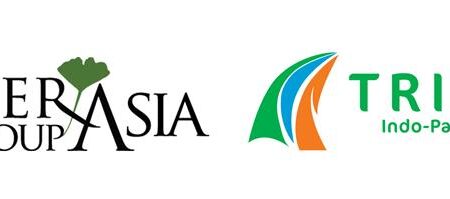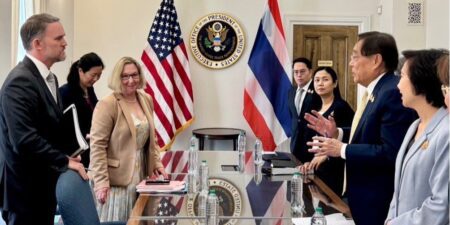
Navigating Global Supply Chain Shifts: Implications for the Philippines

The following is an edited version of written remarks delivered by BGA President and CEO Ernie Bower to a virtual roundtable organized by the Stratbase-ADR Institute entitled “The Private Sector as a Reliable Partner for Economic Recovery” held on March 26. A full version of the deliberations can be seen here.
Thank you Ambassador Del Rosario and Dindo for inviting me to join you today, and for your opening remarks. It is an honor to be with both of you and so many friends from Manila. I am sorry I can’t be with you in person. I hope I will be able to come and visit you in Manila very soon, and that I can welcome all of you to Washington as well.
The topic of Philippine competitiveness is near and dear to my heart. I have been working with many of you for the last three decades and more on promoting investment and trade in the Philippines, not only with my home country the United States, but with all of Asia as well.
Philippine Companies and Competitiveness
Our focus today on the Philippine private sector is most appropriate. Philippine companies are among ASEAN’s finest and management of many top companies here is world class. Your companies have led the way, even ahead of government efforts, in providing pandemic response and relief. Philippine companies tend to invest in their people and communities, and this has a critical impact on the economy and will help drive recovery. And there is no greater force for economic dynamism in the Philippine economy than domestic investment.
Still, it is true that the Philippines is not as well represented as a regional and global investor as some of its ASEAN neighbors, despite some outstanding exceptions such as Jollibee, FirstPacific and Ayala Corporation to name a few.
Additionally, given the level of skill, human talent, outstanding geographic position, size and scale of economy and its vast diaspora of Filipinos around the word, the Philippines is not as core a player in global supply chains as it should be.
There are many reasons for this, but I don’t believe defining the problem is the focus of our agenda today. Instead, we are here to talk about the private sector’s role in driving economic recovery. Let’s look at the situation:
In 2020, the Philippines experienced the worst economic downturn since 1947; GDP shrunk by 9.5 percent. Still, ever resilient, the Philippines is expected to return as a fast-growing economy with a strong bounce in 2021 and into 2022. The IMF’s latest World Economic Outlook projected that the Philippines’ GDP growth would return to 6.6 percent in 2021, higher than the estimated ASEAN-5 growth at 5.2 percent and average world growth at 5.5 percent.
In 2020, Japan, the US, China, and Hong Kong were four major export destinations for the Philippines, respectively sharing 15.5, 15.2, 15.1, and 14.2 percent of its total exports valued at $63.9 billion. In January 2021, over 84 percent of Philippines exports worth nearly $5 billion went to APEC economies.
China is ahead of other markets as the Philippines’ primary source of imports, contributing 24.4 percent of the Philippines’ total in the last year. Most of these imports are electrical products, mineral fuels and machinery.
Pandemic and Global Supply Chain
The Philippines is highly dependent on its Asian neighbors, especially China, for intermediate and export markets. Its reliance on the global value chain made Philippine businesses particularly vulnerable to disruption of foreign supplies and orders during the pandemic’s early stage. The sharpest contraction came in March 2020, where the Philippines saw a 25 percent decrease in product exports and a 26 percent drop in imports year-on-year.
The pandemic shock has been a wake-up call for Philippine businesses to reflect on how to improve the resiliency and flexibility of their production, including increasing inventory capacities, diversifying supply chains and adopting digital technologies.
Companies will also lead the way here in understanding and adapting to global supply chain trends. This is the hottest topic in C-suites of the world’s top global companies. Supply chains are quickly shifting and adapting to new economic and geopolitical realities, and the fast-changing demands of not only consumers and customers, but government regulators who are demanding more accountability, transparency and adherence to new standards in the environment, social and corporate governance (ESG) areas.
Management teams in Manila and around the country are delving into these new trends and requirements and trying to anticipate and adapt to the fast-changing landscape.
The most disruptive dynamic the Philippines, ASEAN and Asia will see over the next decade is much more focused competition between the United States and China. This competition will be fierce, not only in economics and commercial spaces, but in areas like technology (especially digital ad related technologies such as 5G, artificial information, semiconductors and related standards.)
On February 24, U.S. President Joe Biden signed an executive order instituting broad 100-day reviews of supply chains in four areas: semiconductors, large-capacity batteries such as those used in electric vehicles, pharmaceuticals and rare-earth elements. In addition to these reviews, the executive order called for one-year reviews of sectors including defense, ICT, healthcare, energy, transportation and agricultural commodities.
The order outlined a “whole of government” approach, to be coordinated by Assistant to the President for National Security Affairs Jake Sullivan and Assistant to the President for Economic Policy Keith Hennessey, involving Cabinet departments and consulting with outside stakeholders. The resulting reports will drive regulatory and legislative changes in the U.S. and it will influence U.S. partners such as Japan, Korea, India, much of ASEAN and Australia and New Zealand.
The executive order marked a rare spot of bipartisan agreement in bitterly divided Washington, reflecting the growing consensus among U.S. policymakers that the U.S. is overly dependent on fragile supply chains. While the order itself never explicitly mentions Asia in general or China in particular, it was clearly envisioned with China in mind, as each of the four 100-day review industries are especially dependent on China trade. Though the rhetoric selling the order focused on benefits for American consumers and potential job creation in the U.S., it left potential remedies unclear. The most likely outcome of the review will be a push to accelerate both onshoring back to the U.S. and reshoring to friendly countries in Asia.
Expect these new rules to focus on the perceived threat from China that is quickly spreading in the United States. These new rules and standards will represent challenges for Philippine companies who want and need to do business with both China and the United States.
Looking Ahead
So what can be done?
Prior to the pandemic, the Philippines pursued a strategy of export-led growth and moving up in global value chains. In 2012, DTI launched the Industry Development Program to consolidate a national industry roadmap. Since 2016, under the Manufacturing Resurgence Program (MRP), multiple governmental agencies have stepped up their efforts in providing better incentives, training, and other support for improving industry competitiveness. The MRP program set the target of establishing the Philippines as the hub of auto, electronics, machinery, garments, and food production by 2025.
In 2016-2017, DTI and the BOI conducted studies with USAID and Duke University to understand the Philippines’ role in global manufacturing supply chains. The studies identified several key advantages of Philippines’ participation in global supply chains, including its close trade relations with neighboring countries, its continuing attractiveness for foreign investment, and a relatively young, skillful and fast learning workforce.
The Philippines government is actively pushing forward multilateral and bilateral free trade negotiations. After signing the RCEP in November 2020, DTI has announced that it will explore joining the CP-TPP in the future. The Philippines government has also resumed trade negotiation with Korea and expects to finalize the agreement in 2021.
Constraints Faced by Businesses
Regarding the RCEP agreement, there are criticisms that the deal will not significantly expand the export market for Philippine businesses but lead to import inflow from Korea, China, and Vietnam, thus bringing additional challenges to the Philippines’ domestic industries, who are struggling to recover from the pandemic.
Like other Southeast Asian countries, the Philippines can profit from industry reallocation away from China. However, factors such as the business environment may constrain the Philippines to expand its footprint in the regional supply chain. The Philippines ranks 95th in World Bank’s Doing Business index in 2020, behind Vietnam (70th) and Indonesia (73rd).
Conclusion
Philippine business can help address some of these constraints by working together to convince Filipinos and Congress that the amending some of the key economic provisions in your constitution to allow the Philippines to adapt to new global competitiveness requirements, welcome more foreign investment, update labor and environmental laws and position to drive a revolutionary increase in investment and trade.
Philippine companies are among the best managed in Asia. Your people are among the most well-educated and resilient workforce in the world. Your geography and economic scale suggest the Philippines has every natural advantage (except for your exposure to tropical storms and volcanoes, of course.) Believing in these strengths and making the needed reforms will grow the economy of this great country, provide new jobs and linkages to global opportunities and markets and ensure a golden age of prosperity for Filipinos.
Thank you for inviting me.

Ernest Z. Bower
President & CEO

Subscribe to Asia Street
Insights & News


Cambodia Tariff Tracker | July 8, 2025
BGA Cambodia Deputy Managing Director Sophea Ros wrote an update to clients on Cambodia’s trade …
 Sophea Ros
Sophea Ros

BowerGroupAsia and Trinity Indo-Pacific Partners Forge Partnership To Expand Strategic Business Advisory in the Indo-Pacific
BowerGroupAsia (BGA), a leading strategic advisory firm with over 240 people working in 32 countries …
 Murray Hiebert
Murray Hiebert

Thailand Tariff Tracker | July 8, 2025
BGA Thailand Managing Director Teerasak “Art” Siripant and Analyst Jirawat Suriyashotichyangkul wrote an update to clients …
 Teerasak Siripant
Teerasak Siripant
At BowerGroupAsia, we are committed to
delivering result-oriented solutions for our clients
We have proven track record of helping the world’s top companies seize opportunities and manage challenges across the dynamic Indo-Pacific region.



















